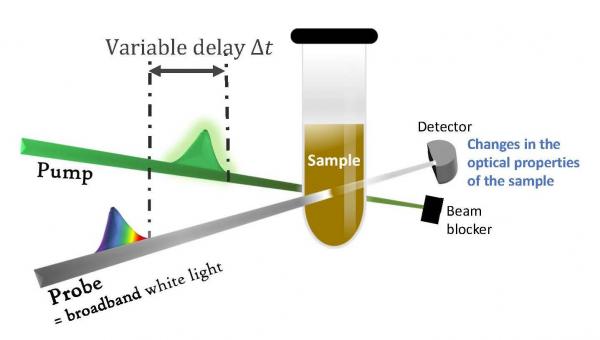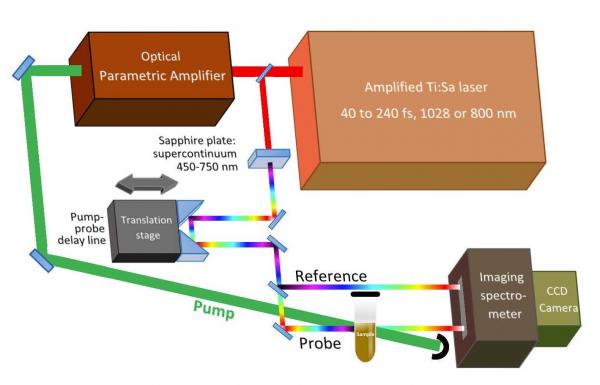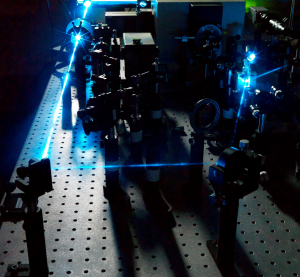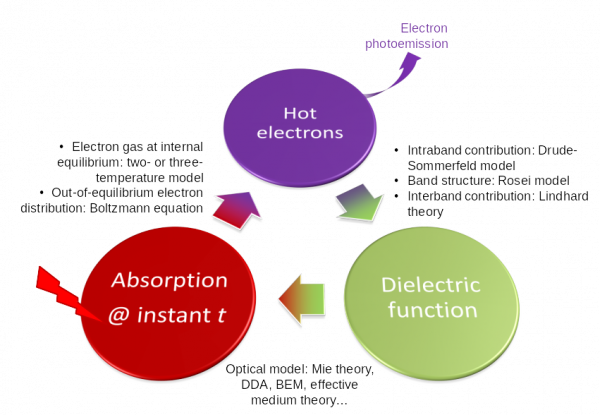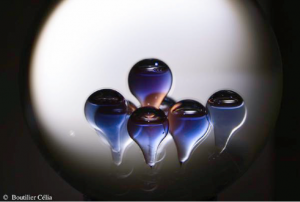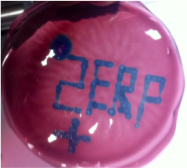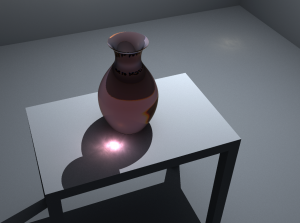Plasmonic nanoparticles: Stationary and ultrafast transient optical responses
P.I.: Bruno Palpant
Upon ultrashort light pulse absorption, plasmonic nano-objects experience a transient change in their optical properties. We have investigated these phenomena for years, by especially elucidating the spectral signature of this ultrafast optical response. More generally, we study the optical properties of plasmonic metal nano-objects.
A sightseeing tour in the history of the Decorative Arts
video in French here
Experimental tools
Our experimental investigations are based on the broadband ultrafast transient absorption spectroscopy, achieved by the femtosecond pump-probe technique.
Briefly, a tunable pump laser pulse interacts with the sample, which affects its optical properties. The latter are monitored by a subsequent probe laser pulse by recording its intensity. The dynamics of the optical response is recovered by modifying the pump-probe delay.
-
The pulse duration varies from 40 to 250 fs.
-
The repetition rate can be varied from 1 kHz to 1 MHz.
-
The peak intensity can reach several GW cm.
-
The pump beam can be tuned thanks to an optical parametric amplifier.
-
The probe beam is a white-light supercontinuum covering the whole visible spectrum.
Modeling
We have developed suited models for describing the series of energy exchanges and relaxation within the metal nano-objects and their environment, from the light pulse absorption to the heat release towards the surrounding medium, including the generation of a hot electron gas, electron ejection out of the NP, real time variation of the NP absorption cross section, metal lattice heating.
Both thermal and athermal approaches can be implemented for describing the electron gas distribution.
Selected achievements
The photo-induced ultrafast modulation of the optical properties of metal nanoparticles can be largely amplified and spectrally tailored thanks to the transient coupling of localized plasmonic and photonic modes. This was realized by setting gold nanoparticles in a hybrid microcavity (Fig., left), the ultrafast transient optical response of which was determined by time-resolved broadband spectroscopy (Fig., middle and right). The plasmon bleaching profile is spectrally forced by the photonic mode of the cavity. Beyond, its magnitude is strongly boosted by the double effect of the transient coupling, impacting both the pump pulse absorption and the cavity properties experienced by the probe beam.
Scheme of a multi-layered hybrid cavity containing a central thin film of gold nanoparticles (left). Transient spectrum of the photo-induced transmittance modulation for a bare layer of gold nanoparticles (middle) and the hybrid cavity (right), as measured by broadband pump-probe spectroscopy. The pump-induced device transmittance variation reaches 107% against a few % only with the bare NP film without cavity.
Transient absorption in non-spherical nanostructures
Non-spherical nano-objects exhibit several plasmon modes at specific spectral location. The interplay of these modes and interband transitions in the metal results in a complex signature of their ultrafast optical response, both in the spectral and relaxation time domains.
We are involved in Art&Science actions in partnership with an artist sculptor specializing in glass, Thomasine Giesecke, as well as colleagues from the Art&Science Chair in Ecole Polytechnique, with the support of Institut de Chimie Physique in Université Paris-Saclay. See a video here: https://vimeo.com/691301145.
Ongoing projects
Ultrafast optical response of complex plasmonic nano-objects
Our goal is to understand the spectral and temporal signatures of the optical response of complex plasmonic nanostructures: non-spherical morphologies, bimetallic nanoparticles, hybrid materials, coupled nano-objects. Understanding these properties will enable us to imagine new applications.
Ultrafast transmittance of hybrid microcavities
Following our work with spherical NPs in a microcavity, we plan to develop the principle of this ultrafast coupling towards more complex and powerful situations by playing with the shape and spatial arrangement of the nano-objects in the microcavity to get more degrees of freedom.
The high local electromagnetic energy density will enable us to generate nonlinear optical effects that we aim at evidencing. The next objective is to control at an ultrashort timescale the near-field energy transfer from plasmonic nano-antennas.
Partners: D. Catone, A. Paladini, P. O’Keeffe & L. Di Mario, IMM, CNR, Rome (Italy); C. Hammon & D. Constantin, LPS, Univ. Paris-Saclay; H. Remita, ICP, Univ. Paris-Saclay; J. M. Chomaz, Chaire Art&Science, Ecole Polytechnique (France); R. Bachelot & S. Kochtcheev, L2n, UTT (Troyes, France).
Related publications
-
Acoustic vibration modes of gold-silver core-shell nanoparticles, Tadele Orbula Otomalo, Lorenzo Di Mario, Cyrille Hamon, Doru Constantin, Francesco Toschi, Khanh-Van Do, Vincent Juvé, Pascal Ruello, Patrick O’Keeffe, Daniele Catone, Alessandra Paladini, and Bruno Palpant, Chemosensors 10 (5), 193 (2022). DOI: https://doi.org/103390/chemosensors10050193.
-
Sharp spectral variations of the ultrafast transient light extinction by bimetallic nanoparticles in the near-UV, Tadele Orbula Otomalo, Lorenzo Di Mario, Cyrille Hamon, Doru Constantin, Khanh-Van Do, Patrick O’Keeffe, Daniele Catone, Alessandra Paladini, and Bruno Palpant, Advanced Optical Materials 9, 2001778 (2021). DOI: 10.1002/adom.202001778
-
Complex-conjugate pole-residue pair-based FDTD method for assessing ultrafast transient plasmonic near field, Tadele Orbula Otomalo, Fabrice Mayran de Chamisso, Bruno Palpant, Plasmonics 15, 495-505 (2020). DOI: 10.1007%2Fs11468-019-01057-x
-
Hexacyano ferrate (III) reduction by electron transfer induced by plasmonic catalysis on gold nanoparticles, Iyad Sarhid, Isabelle Lampre, Diana Dragoe, Patricia Beaunier, Bruno Palpant, Hynd Remita, Materials 12, 3012 (2019). doi:10.3390/ma12183012
-
Time-dependent optical response of three-dimensional Au nanoparticle arrays formed on silica nanowires, Lorenzo Di Mario, Tadele Orbula Otomalo, Daniele Catone, Patrick O’Keeffe, Lin Tian, Stefano Turchini, Bruno Palpant, and Faustino Martelli, Phys. Rev. B 97, 115448 (2018). DOI : 10.1103/PhysRevB.97.115448
-
Coupling localised plasmonic and photonic modes tailors and boosts ultrafast light modulation by gold nanoparticles, X. Wang, R. Moreira, J. Gonzalez and B. Palpant, Nano Letters 15, 2633–2639 (2015). DOI: 10.1021/acs.nanolett.5b00226
-
Broadband spectral signature of the ultrafast optical response of gold nanorods, X. Wang, Y. Guillet, P. R. Selvakannan, H. Remita and B. Palpant, J. Phys. Chem. C. 119 (13), 7416-7427 (2015). DOI: 10.1021/acs.jpcc.5b00131.
-
Coupling of a single active nanoparticle to a polymer-based photonic structure, D. T. T. Nguyen, T. H. Au, Q. C. Tong, M. H. Luong, A. Pelissier, K. Montes, H. M. Ngo, M. T. Do, D. B. Do, D. T. Trinh, T. H. Nguyen, B. Palpant, C. C. Hsu, I. Ledoux-Rak, and N. D. Lai, J. Sci. Adv. Mater. Devices 1 (1),18–30 (2016). DOI: 10.1016/j.jsamd.2016.04.008
-
Large and ultrafast optical response of a one-dimensional plasmonic-photonic cavity, X. Wang and B. Palpant, Plasmonics 8, 1647–1653, 2013. DOI: 10.1007/s11468-013-9583-1
-
Selective cold welding of colloidal gold nanorods, S. C. Laza, N. Sanson, C. Sicard-Roselli, A. Aghedu, and B. Palpant, Particle & Particle Systems Characterization 30, 584–589 (2013). Doi: 10.1002/ppsc.201300026
-
Near- and far-field effects on the plasmon coupling in gold nanoparticle arrays, X. Wang, Ph. Gogol, E. Cambril, and B. Palpant, J. Phys. Chem. C 116 (46), 24741–24747 (2012). DOI: 10.1021/jp306292r
-
One-pot radiolytic synthesis of gold nanorods and their optical properties, W. Abidi, S. Periasamy, Y. Guillet, I. Lampre,P. Beaunier,B. Pansu, B. Palpant, and H. Remita, J. Phys. Chem. C 114 (35), 14794–14803 (2010).
-
Spectral dependence of the ultrafast optical response of nonspherical gold nanoparticles, Y. Guillet, E. Charron, and B. Palpant, Phys. Rev. B 79, 195432 (2009).


